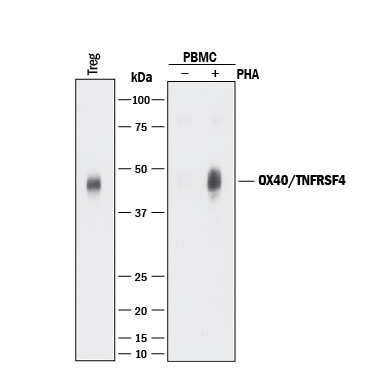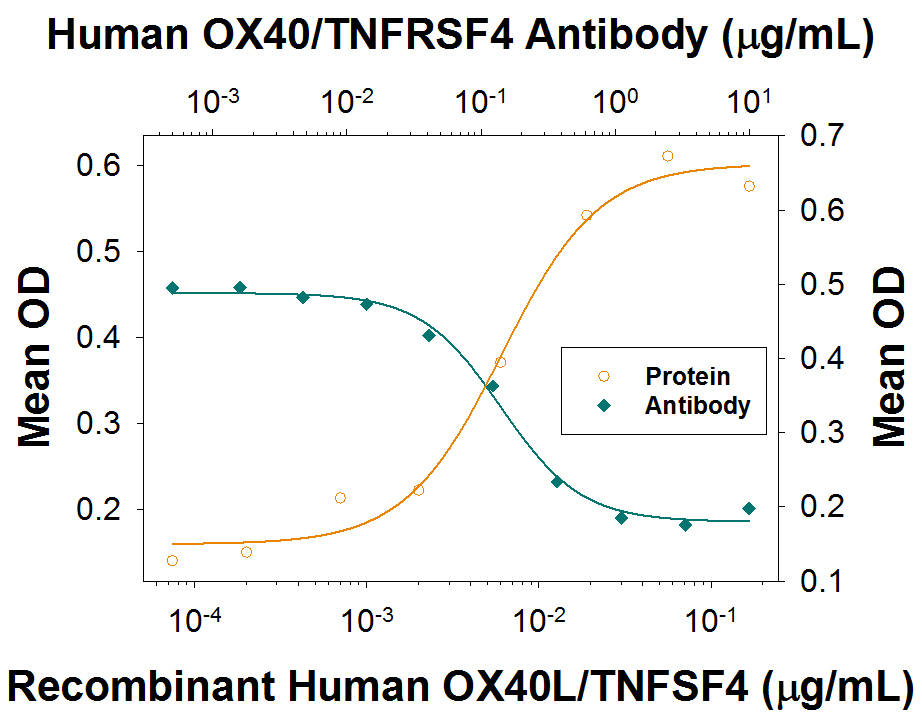Human OX40/TNFRSF4 Antibody Summary
Applications
Please Note: Optimal dilutions should be determined by each laboratory for each application. General Protocols are available in the Technical Information section on our website.
Scientific Data
 View Larger
View Larger
Detection of Human OX40/TNFRSF4 by Western Blot. Western blot shows lysates of human T regulatory cells (Tregs) and human peripheral blood mononuclear cells (PBMCs) untreated (-) or treated (+) with 1 µg/mL PHA for 5 days. PVDF membrane was probed with 0.5 µg/mL of Sheep Anti-Human OX40/TNFRSF4 Antigen Affinity-purified Polyclonal Antibody (Catalog # AF3388) followed by HRP-conjugated Anti-Sheep IgG Secondary Antibody (Catalog # HAF016). A specific band was detected for OX40/TNFRSF4 at approximately 45 kDa (as indicated). This experiment was conducted under reducing conditions and using Immunoblot Buffer Group 1.
 View Larger
View Larger
Detection of OX40/TNFRSF4 in Human T Cells by Flow Cytometry. Human T cells were treated for 3-5 days with 1 µg/mL PHA then stained with Sheep Anti-Human OX40/ TNFRSF4 Antigen Affinity-purified Polyclonal Antibody (Catalog # AF3388, filled histogram) or control antibody (Catalog # 5-001-A, open histogram), followed by NorthernLights™ 557-conjugated Anti-Sheep IgG Secondary Antibody (Catalog # NL010).
 View Larger
View Larger
OX40/TNFRSF4 in Human Tonsil. OX40/TNFRSF4 was detected in immersion fixed paraffin-embedded sections of human tonsil using Sheep Anti-Human OX40/TNFRSF4 Antigen Affinity-purified Polyclonal Antibody (Catalog # AF3388) at 3 µg/mL for 1 hour at room temperature followed by incubation with the Anti-Sheep IgG VisUCyte™ HRP Polymer Antibody (Catalog # VC006). Tissue was stained using DAB (brown) and counterstained with hematoxylin (blue). Specific staining was localized to plasma membrane. View our protocol for IHC Staining with VisUCyte HRP Polymer Detection Reagents.
 View Larger
View Larger
CXCL8/IL-8 Secretion Induced by OX40L/TNFSF4 and Neutralization by Human OX40/TNFRSF4 Antibody. Recombinant Human OX40L/TNFSF4 (Catalog # 1054-OX) stimulates CXCL8/IL-8 secretion in the HT1080 human fibrosarcoma cell line transfected with human OX40/TNFRSF4 in a dose-dependent manner (orange line), as measured by the Human CXCL8/IL-8 Quantikine ELISA Kit (Catalog # D8000C). CXCL8/Il-8 Secretion elicited by Recombinant Human OX40L/TNFSF4 (10 ng/mL) is neutralized (green line) by increasing concentrations of Sheep Anti-Human OX40/TNFRSF4 Polyclonal Antibody (Catalog # AF3388). The ND50 is typically 0.025-0.16 µg/mL.
Reconstitution Calculator
Preparation and Storage
- 12 months from date of receipt, -20 to -70 degreesC as supplied. 1 month, 2 to 8 degreesC under sterile conditions after reconstitution. 6 months, -20 to -70 degreesC under sterile conditions after reconstitution.
Background: OX40/TNFRSF4
OX40 (CD134; TNFRSF4) is a T cell costimulatory molecule of the TNF receptor superfamily that coordinates with other membrane-bound costimulators such as CD28, CD40, CD30, CD27 and 4-1BB (1-3). OX40 is expressed on naïve CD4 + T cells only after engagement of the TCR by antigen presenting cells (APC; dendritic and B cells), and costimulation by CD40/CD40 ligand and CD28/B7. It is maximal at 2-5 days post activation, or 4 hours post reactivation of memory T cells (3-6). Human OX40 is a 48 kDa type I transmembrane glycoprotein with a 28 amino acid (aa) signal sequence, a 185 aa extracellular domain (ECD) that has four TNFR-Cys repeats and an O-glycosylated hinge region, a 20 aa transmembrane segment, and a 41 aa cytoplasmic domain (3). The ECD of human OX40 shows 71%, 68%, 67%, 64% and 64% aa identity with feline, canine, rabbit, mouse and rat OX40 ECD, respectively. Engagement of OX40 on activated CD4 + T cells by OX40 ligand on activated dendritic cells promotes T cell survival and proliferation, prolongs the immune response, and enhances the number of cells making the transition from effector to memory T cells (1-6). OX40 signal transduction includes binding TNF receptor-associated factors (TRAFs), and activating NF kappa B and PI3 kinase to enhance expression of cytokines, antiapoptotic Bcl-2 family members, survivin and the chemokine receptor CXCR5 (5-8). CXCR5 promotes T cell migration to germinal centers to deliver B cell help (5). Studies using knockout or transgenic mice, and agonistic or blocking antibodies, show that OX40/OX40L interaction is critical for establishing or reactivating memory T cells and breaking immune tolerance (9). Blockade of OX40 engagement is efficacious in animal models of allergic airway inflammation, graft-versus-host disease and autoimmune disease (10-14).
- Salek-Ardakani, S. and M. Croft (2006) Vaccine 24:872.
- Hori, T. (2006) Int. J. Hematol. 83:17.
- Latza, U. et al. (1994) Eur. J. Immunol. 24:677.
- Murata, K. et al. (2000) J. Exp. Med. 191:365.
- Fillatreau, S and D. Gray (2003) J. Exp. Med. 197:195.
- Gramaglia, I. et al. (1998) J. Immunol. 161:6510.
- Rogers, P.R. et al. (2001) Immunity 15:445.
- Song, J. et al. (2005) Immunity 22:621.
- Bansal-Pakala, P. et al. (2001) Nat. Med. 7:907.
- Salek-Ardakani, S. et al. (2003) J. Exp. Med. 198:315.
- Jember, A. G. et al. (2001) J. Exp. Med. 193:387.
- Demirci, G. et al. (2004) J. Immunol. 172:1691.
- Blazar, B.R. et al. (2003) Blood 101:3741.
- Higgins, L.M. et al. (1999) J. Immunol. 162:486.
Product Datasheets
Citation for Human OX40/TNFRSF4 Antibody
R&D Systems personnel manually curate a database that contains references using R&D Systems products. The data collected includes not only links to publications in PubMed, but also provides information about sample types, species, and experimental conditions.
1 Citation: Showing 1 - 1
-
Roles of OX40 and OX40 Ligand in Mycosis Fungoides and S�zary Syndrome
Authors: Y Kawana, H Suga, H Kamijo, T Miyagaki, M Sugaya, S Sato
International Journal of Molecular Sciences, 2021-11-22;22(22):.
Species: Mouse
Sample Types: In Vivo
Applications: Neutralization
FAQs
No product specific FAQs exist for this product, however you may
View all Antibody FAQsReviews for Human OX40/TNFRSF4 Antibody
There are currently no reviews for this product. Be the first to review Human OX40/TNFRSF4 Antibody and earn rewards!
Have you used Human OX40/TNFRSF4 Antibody?
Submit a review and receive an Amazon gift card.
$25/€18/£15/$25CAN/¥75 Yuan/¥2500 Yen for a review with an image
$10/€7/£6/$10 CAD/¥70 Yuan/¥1110 Yen for a review without an image



